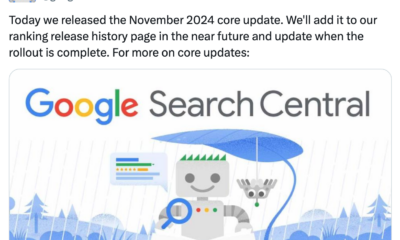MARKETING
How To Earn High-Authority Links That Drive Rankings

The author’s views are entirely their own (excluding the unlikely event of hypnosis) and may not always reflect the views of Moz.
My agency, Fractl, was founded at the dawn of content marketing, when Google launched its war against paid link networks, and SEOs were scrambling to figure out how to earn domain trust signals. At the time, I was heavily invested in viral marketing research, seeking to understand the intricacies of what drove readers to share and, more so, how to pitch journalists to earn media.
Our case studies grew rapidly as we built Fractl’s research-backed Digital PR processes, and we quickly earned a reputation as “The Michael Jordan of Link Building,” as claimed by our client, who just renewed an annual quarter-million investment in our services. Yet, the industry hums with debate on this recent Ahrefs post along with the quote: “I think SEOs may overvalue links from media sites. They really don’t seem to have much impact”.
For starters, let’s trust Google’s own search experts:
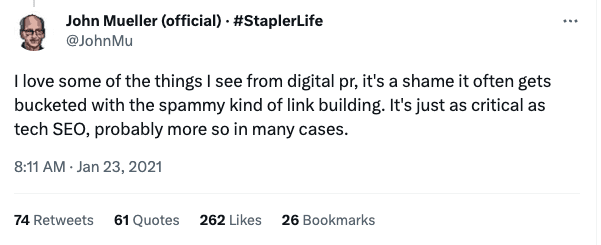
Next, let’s consider several other industry studies and thought leaders:
-
“Obtaining links from more authoritative sites has more value than obtaining a large quantity of links” – Eric Enge
-
“Sites with better quality sites linking to them tend to be higher in rankings” – HubSpot
-
“One good link from a big news site can be more impactful than millions of low-quality links” – John Mueller
Clearly, we’re already building a solid case for how a diverse, authoritative backlink portfolio could help a brand drive its site authority, trust, and organic search rankings. But how can you consistently earn media coverage and avoid spammy link networks?
Ten years ago, I presented viral marketing case studies at MozCon, and while I agree viral marketing isn’t as easy as it used to be in a more saturated industry, I disagree that this kind of ‘earned media’ isn’t valuable to SEO. In my clients’ experience, if “Content is King” then “Digital PR is Queen,” and when executed perfectly, KPIs across SEO, Digital PR, Social, and Sales will all soar.
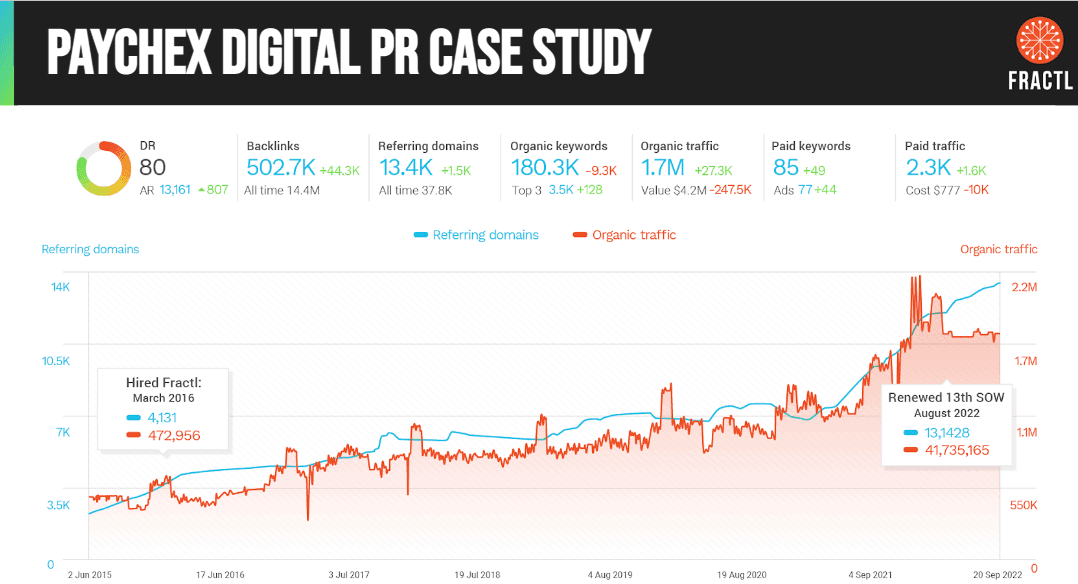
How to earn high-authority links that drive rankings
When I first built Fractl’s Digital PR team, I created a resource for tracking all the publisher feedback we received, which we still utilize today to continuously analyze and refine our processes for earned media. I also spent hundreds of hours interviewing editors and conducting digital PR research to learn: How can we be more effective at creating newsworthy content that breaks through the noise of your inbox?
As content marketing and digital PR go mainstream and more amateurs enter the market, the findings from my research are more important than ever for establishing our industry’s value to publishers versus eroding it with low-quality research and spammed pitches. Here are the four most important lessons I’ve learned over the last decade that will help you execute newsworthy research that publishers love to link to.

1. Your success relies on your ability to educate your client on how to create truly newsworthy research
When it comes to content marketing and digital PR, the most successful teams walk a thin line between creating newsworthy content that writers actually love to cover versus a campaign that will be perceived as sponsored content that will be routed to advertorial for a $100k budget and a minimized link value.
If you want to earn high-authority links, you need to focus on creating content that publishers will perceive as newsworthy: research that is relevant to their readership or the mass consumer, is emotionally compelling and often surprising, is generally tangentially related to your industry and product vs. advertorial, and is educational, or better yet, actionable.
If you’re producing truly newsworthy research, then your pitches will routinely elicit positive responses from writers similar to the ones we receive each week:



For example, imagine you’re a HR management tool, Paychex. You have a traditional PR team that’s pushing your product releases and providing executive interviews to select writers who cover brands in that fashion, so your goal in digital PR is to reach new and engaged readers. What topics are tangentially relevant to your brand that the broader consumer would care about, that you could provide research on, and which high-authority publishers would value?
Content marketing campaigns can take many forms and generally comes down to your budget and talent across data journalism, design, editorial, and PR. Over the last eight years, some of our most link-worthy Paychex research has explored:
-
Analyzing the rise of polywork
-
Job search red flags
-
Employer transparency
-
Remote HR issues
-
Mental health at work
-
Employee discrimination
-
Team morale before & after COVID-19
-
Taking flex-schedules into the future
-
Remote employee benefits
-
Build a retirement fund
-
Retirees rejoining the workforce
-
The onboarding crisis
Our campaign Employee Regret After the Great Resignation is an excellent example of how brands can add value in a breaking news cycle by producing research and providing commentary on trending stories relevant to their niche. This campaign earned hundreds of pickups, with a small sample of high-authority links and brand coverage from:
Ultimately, you should always vet your ideas by asking, “Is this something interesting that I would read, or that I could see myself sharing with a friend?” After all, the best content marketing case studies are legitimately “cool pieces of content.”
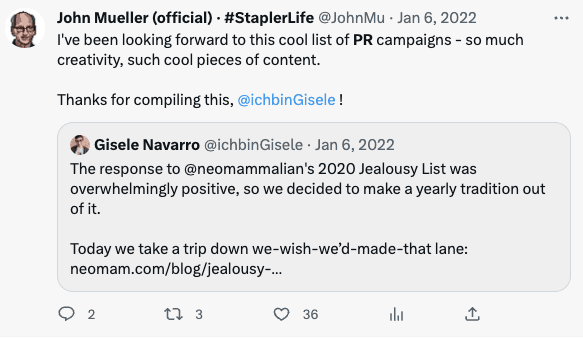
2. Level up your research by adding actionable quotes from clients or industry experts
Once you understand the foundational principles for creating newsworthy research for your brand, the next most valuable thing you can do is to make it actionable. The #1 piece of feedback we’ve received across all of our campaigns has been: “Can I interview your client to go along with my story?”
While research can be interesting and valuable, it often lacks the “actionable” hook that writers know their audience needs. To solve this, writers may send a short Q&A for our client based on the broader theme or takeaways from our research, or they’ll request to hop on a quick call with our data journalists to answer more open-ended questions to expand on our methodology and findings. Here are some examples of requests we’ve received from writers when pitching our campaigns:
“I actually would love to learn more about this. Is someone available to speak with me this week or next?” – CNN
“After speaking with my editor I can confirm interest in moving forward with a story about the four-day work-week, and whether or not it is an inevitability, based on this data. If possible I’m hoping to connect with a spokesperson at some point next week.” – Fast Company
“I am interested in covering this study. I would typically ask some HR analysts at research firms for their input, but I’m certainly interested in what Paychex has to say on the issues of better onboarding processes. That would certainly add color to any article.” – Computer World
Generally, it’s most effective for your digital PR team to field the writer’s Q&A directly since clients are often tied up with their own objectives, and writers expect a near real-time response to secure coverage. In these instances, we typically only comment on our research versus speaking to a broader theme on behalf of our client.
Ideally, instead of being reactive to these requests, you’d solicit a dedicated client PR stakeholder during onboarding and make it clear you need them to commit to a same-day response on high-authority publisher interview requests that are more brand-specific. You would then elicit quotes from this stakeholder during the final draft review stage of any campaign, so your PR team can proactively weave these valuable assets into their pitch.
These interview opportunities can be very exciting to client executives who are eager to build their individual authority and thought leadership in their industry. For example:
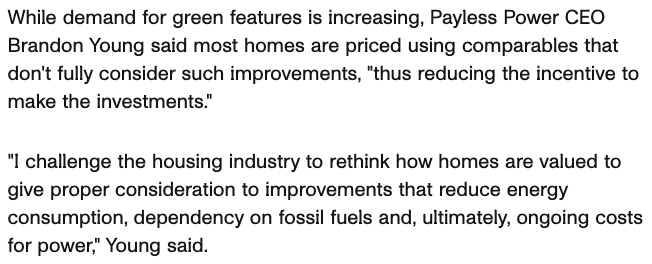
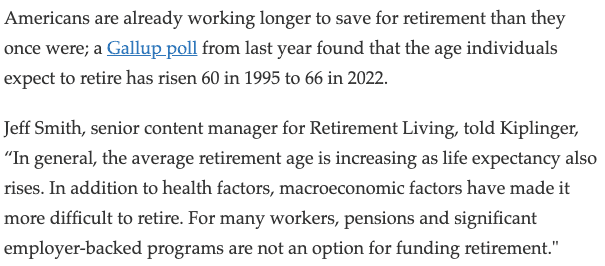
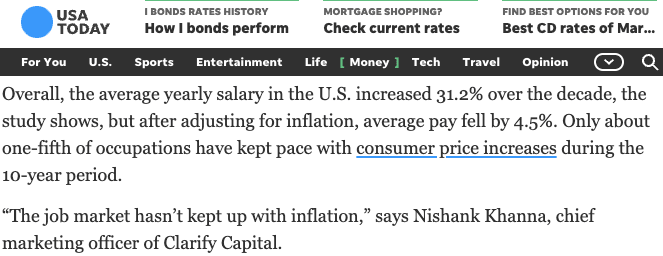
Interview opportunities go a long way in helping your brand provide value to each publisher’s specific audience, so always evaluate how to go the extra mile to deliver actionable advice along with your pitch. In certain circumstances, you might even need to contact external sources, such as nonprofit organizations, who can provide knowledgeable and unbiased opinions in cases where your client isn’t the expert. A great example of this is a female trucker research we produced for a surety bond client, where nearly every editor requested an interview with an actual female trucker. A quick Google search led me to the ‘Women in Trucking’ association, whose board members were more than happy to lend their expertise along with our research:
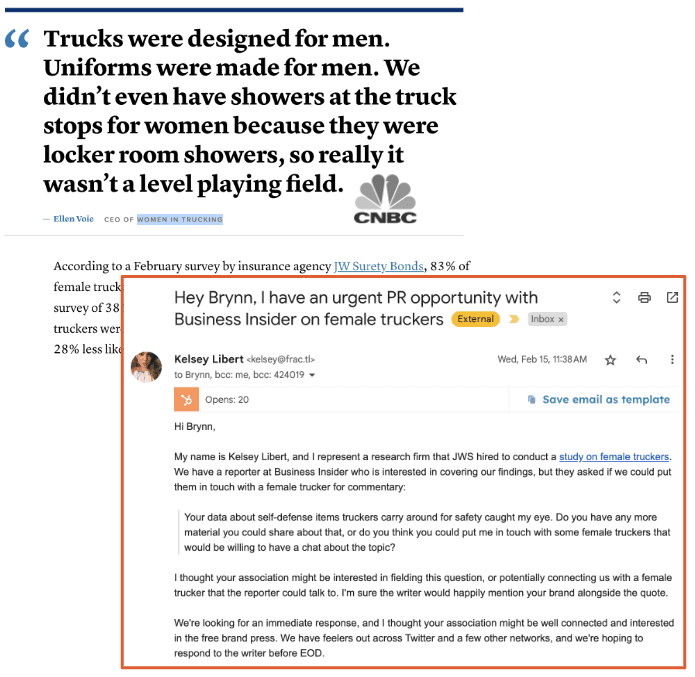
This on-the-fly partnership helped us land over 170 pickups for our client on both mainstream news sites and niche-relevant publishers:
Clearly, the source can come in many forms, but the quotes can be necessary for your success. When in doubt, I always encourage our PR team to include this CTA in the closing paragraph of our pitch: “I’d be happy to offer you an exclusive interview with the CEO, expanding on this research and its implications, if you’re interested”?
3. Always pitch an ‘exclusive’ and preferably password-protect your landing page
While tech publishers are more accustomed to an embargo period on emerging products from Fortune 500 brands, most digital PR teams have the opportunity to provide value in an entirely different way: the ‘exclusive’.

I’ve done a lot of testing over the last decade leading Fractl’s digital PR department, and I’ve consistently found that an exclusive, password-protected landing page generally yields the strongest interest from the most authoritative writers. A password strategy ensures publishers perceive your research as ‘breaking news’, which they have ‘the exclusive’ first rights to release. This can be tantalizing in the editorial world, where pay is often correlated to pageviews and engagement, and breaking news can represent the lion’s share of a site’s engagement.
Whereas an embargo sets an industry-wide deadline for writers to adhere to, an exclusive allows the writer to be the architect of a unique breaking story that doesn’t have to be crammed into their editorial calendar based on an external deadline. It’s also generally more engaging to write a unique story instead of racing a dozen other editors to write the punchiest headline on the same embargoed facts.

Lastly, an exclusive makes a writer feel special since you’ve hand-selected that person instead of using a poorly targeted mass blast approach, which is far too prevalent in the PR industry. In fact, the ‘spray and pray’ tactic will often leave you in an agency-wide ban folder if you’re targeting isn’t on point. I’ve heard about this very real danger in writer interviews I’ve conducted, and Michael Smart attests to this same jaw-dropper in his recent PR newsletter:

In the dawn of artificial intelligence (AI), your time spent investing in meaningful relationships with relevant writers in your industry will be critical to your success.
4. Investing in relationship building by personalizing your pitch vs the ‘spray and pray’ approach
With newsjacking or reactive PR, it’s essential to quickly scale your pitching efforts to provide value in a rapidly evolving breaking news cycle. However, when you’re pitching more evergreen research or working in-house or for a select number of clients, it’s far more important to build a meaningful relationship with a writer by taking a moment to connect with them on a personal level.
These are the primary data points I seek out when first attempting to personalize my pitch:
-
What does their author bio say about their personal interests?
-
Where do they live?
-
Where did they go to school?
-
Do they have any kids or pets?
-
Have they celebrated any major milestones recently?
-
What topics matter to them based on what they post and engage with on social media?
-
What is their tone like in their writing, and how can I match that in my pitch?
While a few people may gasp at this in-depth personal research, stating, ‘I don’t want to be perceived as a stalker,’ I have hundreds of receipts where writers praise our team for taking the time to personalize a pitch:
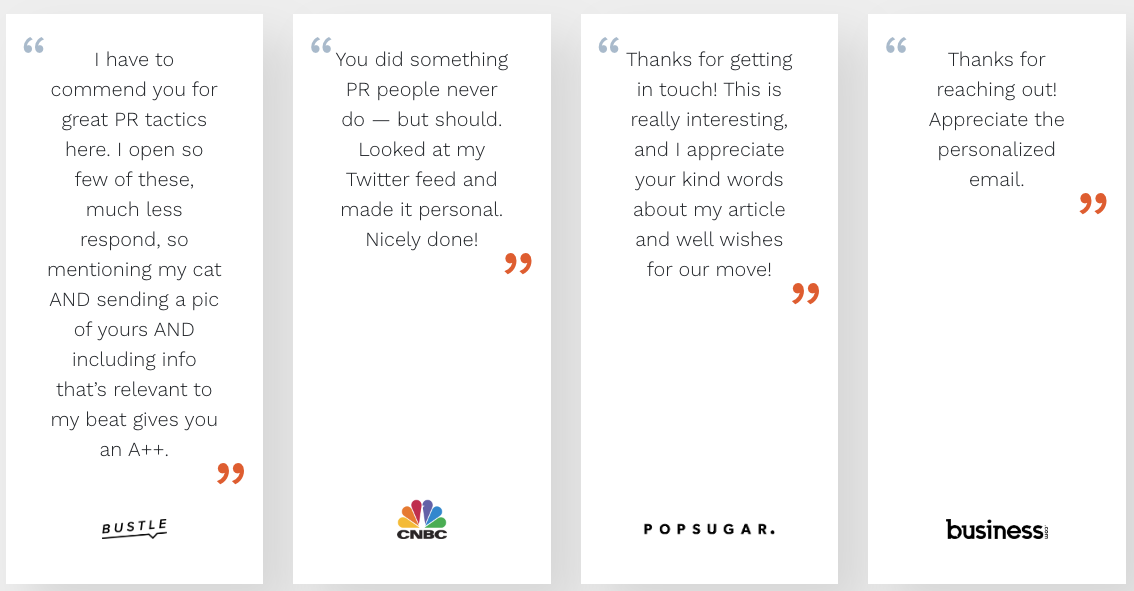
I often find that if a writer is ‘putting it out there’ they generally appreciate you taking the time to research those facts and connect with them personally on it when relevant. Need inspiration for how to personalize your pitch? Check out some of the writer responses from our personalized subject lines and intros:
Writer Responses to Fractl Pitches:
-
I appreciate you checking out my Twitter.
-
LOL hair trauma! So much of it!
-
I am a huge sucker for dog photos.
-
It’s a pleasure to (virtually!) meet another habitual cleaner!
-
Hahaha, love it! 80s songs are the best!
-
Ah yes, truly addicted to Love Island. So here for the drama!
-
So glad you noticed the skyline and got a little hit of nostalgia!
-
Always happy to meet another Ravenclaw meets Slytherin!
-
Always good to know there are other eyeliner-loving, cheese-eating gals out there!
-
Glad I’m not the only dessert fan. 😉
-
Nice, I’m headed back to Michigan for the first time since leaving.
-
Thank you. You sound like a great mom!
-
I’m sure you can do a marathon, too! It’s all about prepping for it!
-
I’m always glad to hear from another skee ball fan!
-
I strongly agree, it took me a while to not regret my college choices!
-
Thanks for your kind words… I was born with a ton of energy!
-
I appreciate your affinity for Baby Yoda.
-
I, too, am pretty big on Scotch.
-
*laughs* Naturally, one can only do so much sassmouthin’.
By differentiating your pitch with personal connections for that individual writer, you’re also quickly demonstrating that you likely did in-depth research to ensure you’re pitching something relevant to this writer that they would value and avoiding journalist pet peeves.
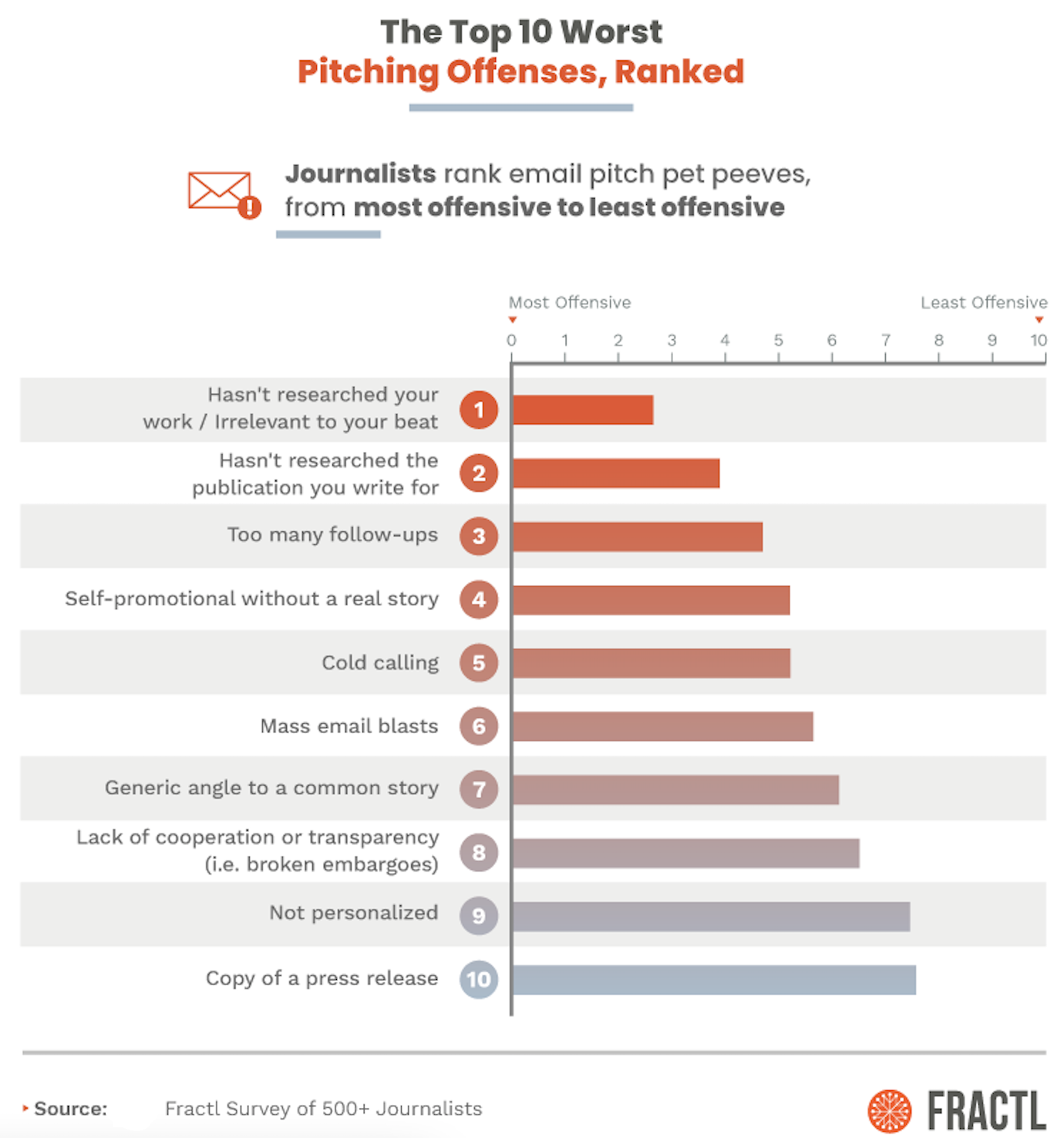
In practice, a well-personalized pitch can look like this:
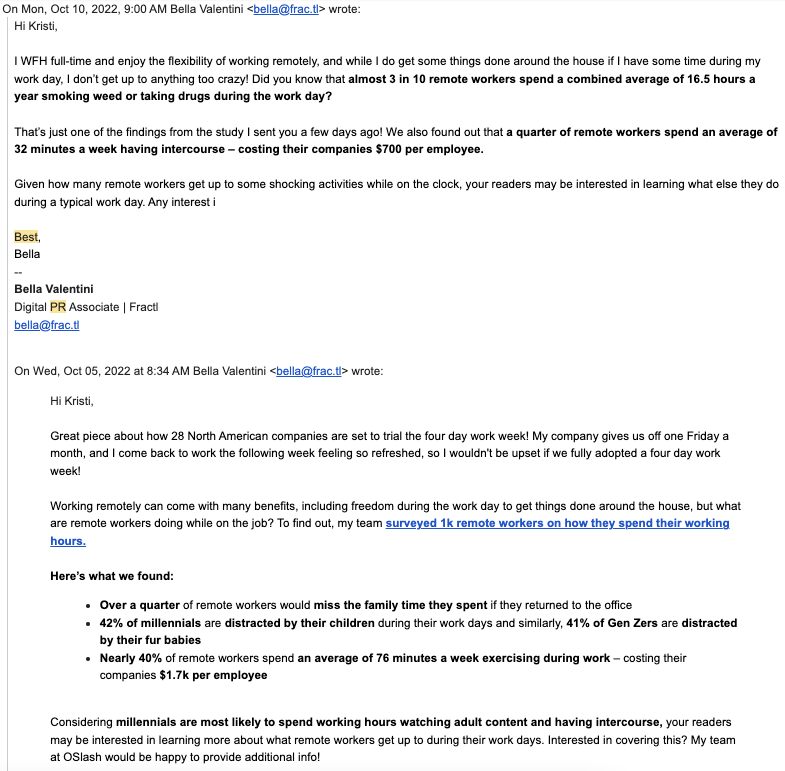
And the Huffington Post writer’s response says it all:

The KPIs of digital PR and earned media
When executed exceptionally well, this style of PR research can consistently earn high-authority links that drive trust signals and organic search rankings, which can offer a higher ROI and more long-term value than paid channels that require the faucet to constantly be ‘on’ to deliver value. Beyond SEO metrics, this strategy also creates a platform for industry thought leadership, exposes new customers to your product, drives consumer engagement, and produces content that can be repurposed to provide cross-channel value across your social media marketing (SMM), pay-per-click (PPC), and email marketing strategies and throughout your buyer’s journey.
Any SEO professional that’s not a snake oil salesman will tell you that link-building alone is not a silver bullet for organic search rankings. The most effective content marketing and digital PR teams deliver a comprehensive organic search strategy, where they’re focusing on both on-page and off-page strategies to drive organic search growth:
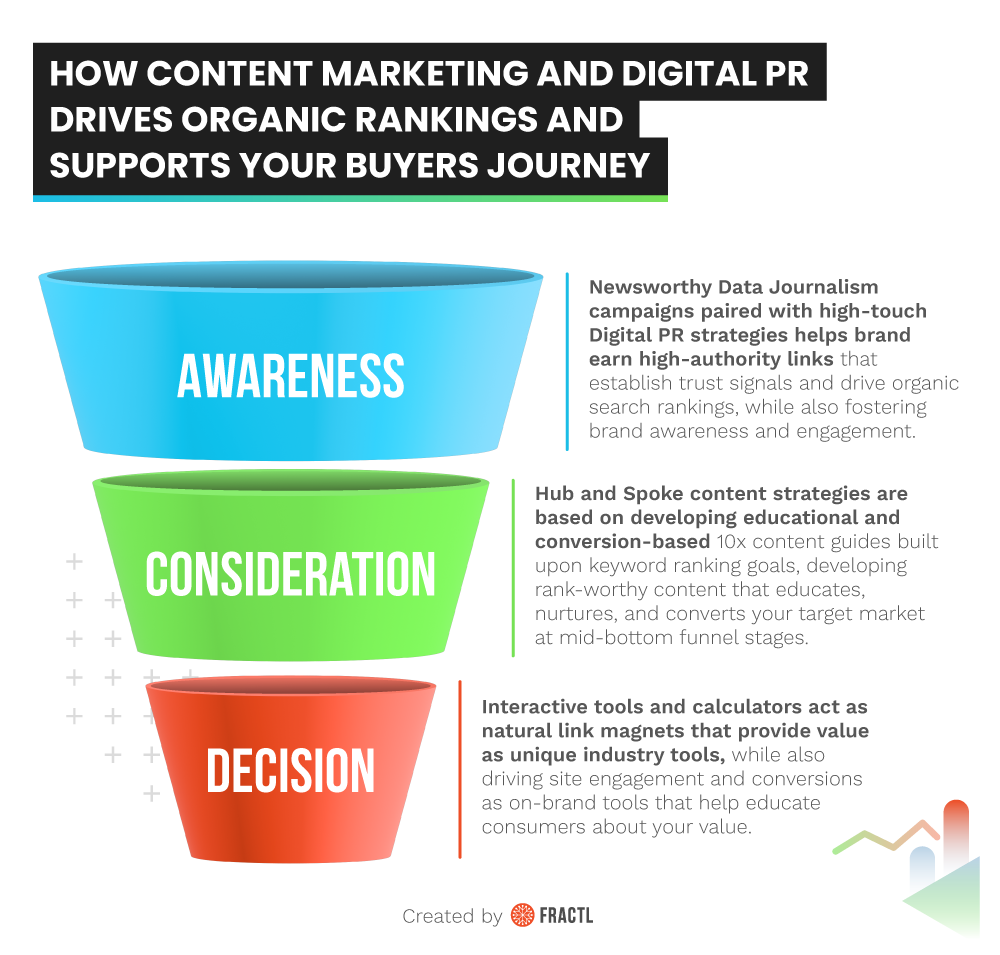
While the increasing lack of attribution for organic search will forever be a struggle, these are the KPIs our clients use to evaluate our work, which we solicit at the start of each engagement so we can report on the KPIs that matter to each of our clients:
- Imagine we are at the end of our statement of work (SOW) together. What does success look like to you?
-
“As many do-follow backlinks from top tier domains as we can get, resulting in an overall increase in website keyword rankings and traffic growth.”
-
“High quality/quantity links, great content/studies, and rankings.”
-
“Acquiring high authority links at a velocity that will allow us to reverse the organic traffic trend we’re currently seeing and get closer to early 2021 levels.”
-
“A high number of top authority placements across all of our campaigns. We want to be able to show notable growth in our backlink portfolio.”
-
“Minimum success threshold is 100 linking domains across the five campaigns, comprising a mix of authority and follow/nofollow. Strong success is 200+ linking domains and meaningful referral traffic from those links.”
-
Most of our clients are founders, SEO directors, marketing directors, or PR managers who are aligned on these same goals, now more than I’ve seen in the last ten years of running Fractl. What’s enabled us to remain a clutch industry leader as competition heats up? Our ability to consistently produce content and PR strategies that drive organic search and the bottom line:
![How To Earn High-Authority Links That Drive Rankings Fractl Content Marketing Case Study [HR Vertical]](https://articles.entireweb.com/wp-content/uploads/2023/08/1690867568_726_How-To-Earn-High-Authority-Links-That-Drive-Rankings.png)
![How To Earn High-Authority Links That Drive Rankings Fractl Content Marketing Case Study [Home Vertical]](https://articles.entireweb.com/wp-content/uploads/2023/08/1690867568_938_How-To-Earn-High-Authority-Links-That-Drive-Rankings.png)
![How To Earn High-Authority Links That Drive Rankings Fractl Content Marketing Case Study [Security Vertical]](https://articles.entireweb.com/wp-content/uploads/2023/08/1690867569_690_How-To-Earn-High-Authority-Links-That-Drive-Rankings.png)
![How To Earn High-Authority Links That Drive Rankings Fractl Content Marketing Case Study [Health Vertical]](https://articles.entireweb.com/wp-content/uploads/2023/08/1690867569_805_How-To-Earn-High-Authority-Links-That-Drive-Rankings.png)





